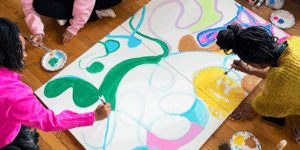 From July through September of this year, the Everson Museum of Art (Everson) showcased the work of Frank Buffalo Hyde, a local Onondaga Nation artist. His homecoming exhibit drew audiences with interests in indigenous culture, history and traditions, and contemporary visual art and sculpture.
From July through September of this year, the Everson Museum of Art (Everson) showcased the work of Frank Buffalo Hyde, a local Onondaga Nation artist. His homecoming exhibit drew audiences with interests in indigenous culture, history and traditions, and contemporary visual art and sculpture.
Originally born in Santa Fe, New Mexico, Hyde grew up in the Onondaga Nation. Throughout his childhood, he often assisted his father, a sculptor, with creating tribal sculptures. As he experimented with different mediums of art, he developed an interest in painting at the age of 18 and later decided to become a full-time artist at 21.
In July, the Everson hosted Hyde’s first solo exhibit in New York State. Hyde used the exhibit, Native Americana, as a vehicle to juxtapose his heritage’s imagery, traditions, and customs against 21st-century pop culture—seeking to dismantle stereotypes and invite audiences to re-think the portrayal of Indigenous people and culture in society and media.
“Native Americana is an investigation of where “American” and “Native American” begin and end and where they intersect,” said Hyde. “Pop culture is reconfigured through the Native American perspective, recognizing that Native American culture has been commodified and serialized. “
In addition to large-format paintings featuring themes of Indigenous Futurism, Native Americana included a variety of interactive and mixed-media installations throughout the museum. Garth Johnson, curator of ceramics at the Everson, explained how Hyde collaborated with staff members at the Everson to build out the multifaceted exhibit.
“Native Americana was all Frank’s vision,” Johnson said. “The most collaborative parts of the exhibition were the installations and the graphic design, which was all brainstormed by Frank, but mainly built by us here at the Everson. No detail was too small –from the “literature” in Frank’s outhouse to the way the radio-controlled bison were styled, Frank had final say, but we certainly enjoyed building and gathering.”
To complement Hyde’s exhibit, the Everson implemented a series of related educational programming for adults and children to engage Indigenous communities, welcome and support new audiences and create thought-provoking dialogue about dismantling systems of historically marginalized groups. To support these efforts, the Everson received a $30,000 Community Grant from the Community Foundation.
The grant funding allowed the Everson to contract various Haudenosaunee activists and performers to lead community outreach programs, performances and art-making workshops inspired by Native Americana. This included performances by Johnny Ray and the Stone Throwers, Dancer Heath Hill’s Dance Group, the Haudenosaunee Katyohkwa and hands-on activities led by Natasha Smoke Santiago, a Mohawk potter and the Everson’s artist-in-residence.
To help visitors contextualize Native Americana, Hyde also led gallery walkthroughs of his exhibit and hosted virtual reality demonstrations for museum patrons.
“Frank is truly at the forefront of Indigenous art,” Johnson said. “He has always followed his own North star rather than art world trends. Because of his use of humor, he can sneak barbed messages into paintings that appear to be fun and happy on their surface.”
Hyde’s work can be found in the collections of the Smithsonian Museum of the American Indian, the Hood Museum of Art, the Gilcrease Museum, the Peabody Essex Museum, and of course, the Everson.
The Everson hopes to continue providing space and opportunities for Indigenous culture to be highlighted and celebrated. Johnson noted Hyde’s driven nature, and his ability to follow his own path in the multifaceted world of art as an indigenous artist.
 “Highlighting Indigenous voices is imperative,” Johnson said. “Especially the Onondaga, who have a very special role as the firekeepers of the Haudenosaunee. An artist of Frank’s caliber who is FROM Syracuse is imperative to feature and doubly so because of his Onondaga roots.”
“Highlighting Indigenous voices is imperative,” Johnson said. “Especially the Onondaga, who have a very special role as the firekeepers of the Haudenosaunee. An artist of Frank’s caliber who is FROM Syracuse is imperative to feature and doubly so because of his Onondaga roots.”









